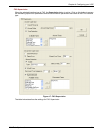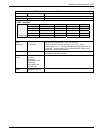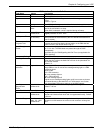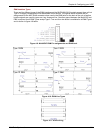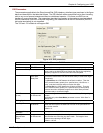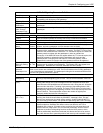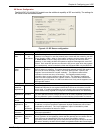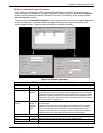
Chapter 4: Configuring your VOIP
Multi-Tech Systems, Inc. 54
H.323 Call Signaling Parameter Definitions.
Field Name
V
alues Description
Use Fast Start Y/N Enables the H.323 Fast Start procedure. May need to be enabled/disabled for
compatibility with third-party VOIP gateways.
Signaling Port
port
Default: 1720 (H.323)
Register with
Gatekeeper
Y/N Check this field to have traffic on current VOIP gateway controlled by a
gatekeeper.
Allow Incoming
Calls Through
Gatekeeper Only
Y/N When selected, incoming calls are accepted only if those calls come through the
gatekeeper.
GateKeeper RAS Parameters
Primary GK -- This is the preferred gatekeeper for controlling the traffic of the current VOIP.
Alternate GK
1 and 2
-- A first and a second alternate gatekeeper can be specified for use by the current
VOIP for situations where the Primary GK is busy or otherwise unavailable.
IP Address
n.n.n.n
IP address of the GateKeeper.
RAS Port 1719 Well-known port number for GateKeepers. Must match port number (1719).
Gatekeeper
Name
alpha-
numeric
Optional. The name of the GateKeeper with which this MultiVOIP is trying to
register. A primary gatekeeper and two alternate units are listed.
RAS TTL Value
seconds
The H.323 Gatekeeper “Time to Live” value. As soon as a MultiVOIP gateway
registers with a gatekeeper a countdown timer begins. The RAS TTL Value is the
interval of the countdown timer. Before the TTL countdown expires, the MultiVOIP
gateway needs to register with the gatekeeper in order to maintain the
connection. If the MultiVOIP does not register before the TTL interval expires, the
MultiVOIP gateway’s registration with the gatekeeper will expire and the
gatekeeper will no longer permit call traffic to or from that gateway. Calls in
progress will continue to function even if the gateway becomes de-registered
Gatekeeper
Discovery Polling
Interval
integer
60 - 300
The interval between the VOIP gateway’s successive attempts to connect to and
be governed by a higher level gatekeeper. The Primary GK is the highest level
gatekeeper. Alternate GK1 is second; Alternate GK2 is the lowest.
Use Online
Alternate
Gatekeeper List
When selected, VOIP will seek an alternate gatekeeper (when none of the 3 gatekeepers
shown on this screen are available) from a list. The list will reside on the Primary gatekeeper
or one of the Alternate gatekeepers. The gatekeeper holding the list would download that list
onto the VOIP gateways within the system.
H.323 Version 4 Options
H.323
Multiplexing
Y/N Signaling for multiple phone calls can be carried on a single port rather than
opening a separate signaling port for each. This conserves bandwidth resources.
H.245 Tunneling
(Tun)
Y/N H.245 messages are encapsulated within the Q.931 call-signaling channel.
Among other things, the H.245 messages let the two endpoints tell each other
what their technical capabilities are and determine who, during the call, will be the
client and who the server. Tunneling is the process of transmitting these H.245
messages through the Q.931 channel. The same TCP/IP socket (or logical port)
already being used for the Call Signaling Channel is then also used by the H.245
Control Channel. This encapsulation reduces the number of logical ports
(sockets) needed and reduces call setup time.
Parallel H.245
(FS + Tun)
Y/N FS (Fast Start) is a Q.931 feature of H.323v2 to hasten call setup as well as ‘pre-
opening’ the media channel before the CONNECT message is sent. This pre-
opening is a requirement for certain billing activities. Under Parallel H.245 FS +
Tun, this Fast Connect feature can operate simultaneously with H.245 Tunneling.
Annex –E (AE) Y/N Multiplexed UDP call signaling transport. Annex E is helpful for high-volume VOIP
system endpoints. Gateways with lesser volume can afford to use TCP to
establish calls. However, for larger volume endpoints, the call setup times and
system resource usage under TCP can become problematic. Annex E allows
endpoints to perform call-signaling functions under the UDP protocol, which
involves substantially streamlined overhead (this feature should not be used on
the public Internet due to potential problems with security and bandwidth usage).



